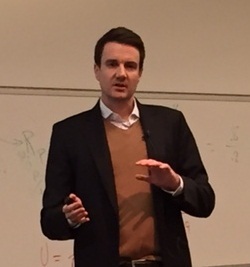This Antiseptic Was Brought to You By …: USAID guide mimics some market practices to speed ‘bench to bedside’
When it comes to global health, “people are good at inventing things but not always good at reaching scale,” according to David Milestone, senior adviser at the U.S. Agency for International Development’s Center for Accelerating Innovation and Impact (CII).
That’s why USAID developed “IDEA to IMPACT: A Guide to Introduction and Scale of Global Health Innovations,” which officially debuted on Monday.
CII Director Wendy Taylor, in her introduction to the guide, says it covers the “priority activities” practitioners should take “to ensure successful launch and scale from bench to bedside.”
Milestone, speaking Jan. 28 at the University of Michigan as a guest of the William Davidson Institute (the parent organization of NextBillion), said it typically takes global health solutions “decades to reach even a percentage of their intended users. But U.S. (private) drug launches take five to eight years to reach intended markets.” He admitted that the comparison is not apples to apples – “Global health is complicated” – but added, “We think there’s something we can learn from the private sector and how they introduce and scale products.” Many “best practices” from both the public and private sector are included in the guide.
USAID launched CII two and a half years ago to apply business approaches to health interventions around the world.
Milestone’s team has done some “proof of concept” work with chlorhexidine, a low-cost antiseptic which, if applied to the umbilical cord after birth, can save lives in developing countries.
USAID organized clinical trials of chlorhexidine in Nepal, developing a brand and communications campaign around the antiseptic. “It’s tracking pretty well,” Milestone said, “showing we can achieve pretty rapid scale-up in specific markets.” The work has proven, in fact, to “reduce mortality up to 40 percent, on average about 23 percent.”
The ultimate goal is to enable better planning for introducing products, even in advance of approval by health regulators, and use of global financing levers to shape markets.
 Private firms tend to know their end users, having put in the requisite market research, Milestone (left) said, “while we don’t always do that well.” In advance to scaling up chlorhexidine in other countries – specifically Nigeria, Pakistan and Bangladesh – USAID is organizing market research to understand, “What is this mother in northern Nigeria thinking about? What are they currently purchasing in advance of the birth? What would their family think of them using chlorhexidine?”
Private firms tend to know their end users, having put in the requisite market research, Milestone (left) said, “while we don’t always do that well.” In advance to scaling up chlorhexidine in other countries – specifically Nigeria, Pakistan and Bangladesh – USAID is organizing market research to understand, “What is this mother in northern Nigeria thinking about? What are they currently purchasing in advance of the birth? What would their family think of them using chlorhexidine?”
IDEA to IMPACT recognizes that successful product introduction often comes back to better coordination and earlier planning, Milestone said. Along those lines, the guide lays out a four-stage plan for innovative products: user needs and design; research and development; a plan for introduction; and introduction and scale.
Dalberg did a theoretical analysis, Milestone said, and found that if a traditional global health launch takes 20 years, and you’re able to accelerate that by just one year, about 10 percent more people can be reached over time. That can translate into thousands of lives. “Just by planning and doing things in a more rigorous way, can save a lot of lives,” Milestone said. “If you don’t get the launch off on the right foot in the first six months it’s much harder to recover.”
Milestone also presented a real-world challenge for the audience to consider. Chlorhexidine is cheap and easy to make, costing end users in Nepal about 25 cents per use. It makes sense to produce it locally, because when you ship it from, say, Nepal to Nigeria, it doubles the cost. Meanwhile, a large pharmaceutical firm is part of a chlorhexidine working group and wants to make and sell the antiseptic to local governments. USAID worries that the firm’s market entry could serve to disincentivize local manufacturers, but has no authority to impede the company, which has already made related investments. The ideal solution, Milestone suggested – and the direction USAID is pushing – is for the company to provide oversight, technical assistance and fill supply gaps, while local and/or regional firms manufacture the chlorhexidine and leverage their association with the multinational firm.
Milestone also told about some of the lessons USAID has learned in its effort to increase the use of microbicides – products that can be applied vaginally and have been proven to prevent sexual transmission of HIV. Despite the demonstrated results of microbicides, women too seldom use them in the developing world, Milestone said, because the applicator is poorly designed. This resulted in USAID getting more focused on human-centered design.
“We brought in experts,” Milestone said, and they spent time in South Africa talking to potential end users about barriers to use. The questions included, “What can we communicate to these women that would make them actually use it, rather than trying to scare them into using this product? Usually, Coca-Cola doesn’t try to scare people into using their product. And sometimes that’s what we try to do in global health.”
The Aspen Institute hosted Monday’s launch of IDEA to IMPACT.
Kyle Poplin is editor of NextBillion Health Care.
- Categories
- Environment, Health Care
